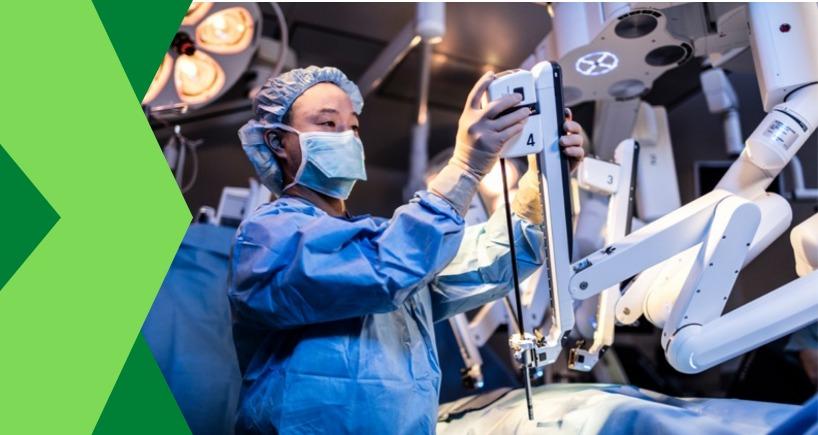
Robotic Cancer Surgery
Robotic Surgery for Cancer: Advantages, Benefits and Long-term Outcomes for Patients
A diagnosis of cancer can be an extremely stressful experience for patients, families and caregivers. Yet, learning the facts about the condition and the best available treatment options before choosing the way ahead is important. Cancer treatments include surgery, radiation, chemotherapy and other therapies to help cure or shrink cancer or stop the progression of a cancer. For patients requiring surgery as part of their treatment, doctors sometimes perform robotic surgery to help remove hard to reach tumours, shorten surgery or recovery times, or lessen the side effects as compared to traditional procedure which is performed by cutting into and opening the body. The Fortis Hospital, Mulund, offers cutting-edge robotic treatments in oncology, gastroenterology, gynaecology, hepatology, and urology. The hospital’s robotic surgery program provides access to the world’s most advanced surgical robotic system, 4th Generation Da Vinci Xi, that allows surgeons to perform complex procedures with greater precision, flexibility, and control.
What is robotic surgery?
Robotic surgery, also known as robotic-assisted surgery, is a form of surgical technique in which surgeons direct the procedure using the robotic tools. The fact is, robotic is not an invasion of a human profession by a machine, neither it has evolved to replace the human hand completely. It is merely an excellent application of technology in order to make surgery safer and, of course, give better results to the patients. Robotic surgery was first done in 1985 when one of the robotic arms was used for cholecystectomy. The real breakthrough occurred when a company launched their first surgical robot, dubbed the da Vinci Surgical System, which was cleared by the Food and Drug Administration in 2000. The FDA cleared the robot for prostate removal (radical prostatectomy) the following year. Since then, robotic surgery has been used in various procedures - with cardiac surgery being one of the earliest procedures that it was tried for.
Robotic surgery essentially consists of three parts:
- The patient-side robotic cart with three arms usually seen at the back side and is thought as the robot with three arms.
- The vision cart is essentially the brain of the robot which carries the monitors, the software and the computer in order to run the robotic systems.
- The surgeon cart is where the surgeon sits and operates.
There is also a bedside surgeon who usually needs to be accomplished or equally expert in cancer surgery because the reaction time sometimes must be extremely fast.
Robotic surgery and cancer
Legend has it that a urologist, incidentally of Indian origin, thought of applying robotics in prostatic surgery. From then on, history was made because it found excellent application in robotic cancer surgery. In the last decade or so, the availability and the adaptation of advanced technology to cancer surgery, and the increasing development of skill sets among the surgical community has led to prolific use of robotics in cancer surgery as well. The surgery of radical prostatectomy has completely been revolutionised by robotic surgery.
Cancers that can be treated with robotic surgery
A lot of people assume that robots can be used for all forms of cancer. On the contrary, robotic surgery can be used for certain cancers located in deep cavities – such as colon cancer, colorectal cancer, stomach cancer, breast cancer, food pipe or oesophageal cancer. Cancers located in the GI tract can be treated with robotic surgery. In the thoracic cavity, cancer of the lung, cancer of the heart, tumour of the thymus gland can also be treated with robotic surgery.
Advantages of robotic surgery over conventional laparoscopy (or ‘straight-stick’ surgery)
We now have enough data to suggest that laparoscopic surgery is as good as open surgery for treating cancer both in terms of long-term results and cure. As laparoscopic surgery becomes widely popular, the next thing that was thought about was robotic surgery. Surgery by robots has several advantages compared to conventional laparoscopy. For instance, the console uses high-definition cameras, which allows surgeons to see the abdomen and pelvis clearly. Also, the depth perception is much better during the surgery (especially when one is operating in deep spaces) because of the 3D view, which will help make better judgments about the various important structures that lie near each other - in contrast to a 2D view of conventional laparoscopy.
It also gives an immersive effect because the operating surgeon’s head is completely immersed in the console, thereby resulting in less distraction as far as the OT is concerned. The robotic instruments have an endo wrist, which means that these instruments function almost like the human wrist. They can give seven degrees of freedom and can rotate almost 360 degrees going around structure.
Robotic surgery also gives you the advantage of magnification, hence, structures appear noticeably clear. In most studies, it has been seen that the amount of blood loss in robotic surgery is much lesser as compared to open surgery. Cancer surgery also involves long hours of standing. In robot-assisted surgery, the surgeon can sit comfortably and operate on patients, which will improve ergonomics as well as the overall well-being of the surgeon.
Benefits of robotic surgery for patients
Most studies conducted across the world showed that the chances of conversion are much lesser in robotic surgery compared to laparoscopic surgery. Secondly, the short-term outcomes such as pain, hospital stay, are lesser as compared to laparoscopic or open surgery. This means patients who underwent major surgeries like rectal cancer or stomach cancer can go home in 3-4 days. They can also resume their work faster as compared to having large incisions on abdomens, which can cause severe pain and a lot of morbidity. The chances of contracting infection in the wounds are also much lesser as the wounds required in robotic surgery to extricate the specimens are exceedingly small.
So, patients have:
- Reduced pain
- Shorter hospitalisation
- Faster recovery time and return to normal activities
- Reduced risk of incision due to smaller incisions
- Minimal scarring
- Reduced blood loss
Long-term outcomes of robotic surgery
Robotic surgery is equivalent to conventional open surgery as far as the long-term outcomes and the completeness of cancer excision are concerned. A large study comparing the open laparoscopic and robotic surgery showed that the completeness of tumour excision, including removal of lymph nodes around the tumour, is equivalent in either of the approaches.
I have also been studying the long-term survival (i.e., chances of recurrent of cancer or cure from cancer) of robotic surgery. It has been seen that robotic surgery does not decrease the chances of cure or increase the risk of cancer recurrence. The chances of getting completely cured from robotic surgery is same as that of conventional surgery.
So, you have better short-term benefits, less pain, faster recovery, and the same outcomes.
The bottom line
The horizon for evolving robotic technology is, perhaps, exciting. We soon expect that there will be a technology to give haptic feedback, which means we might be able to feel the structure that we are holding - something that is wanted in laparoscopic or robotic surgery. There is also a concept of image guidance surgery where high quality MRI images will be fed into the robot who will guide the surgeon to avoid any important structure that could accidentally be injured while operating. This will make the learning curve easier for surgeons and increase the availability of expertise across areas where cancer surgery is not easily available.
We are also looking at something called single-port robotic surgery, which means there will be only one cut through which all the robotic arms will go inside the body and then spread out in order to achieve the same results without the need to take a separate incision or make multiple punctures on the abdomen for tumour extraction.
To conclude, robotic surgery unquestionably has a great future, and it will certainly augment the skills of surgeons all
Categories
Clear allMeet the doctor

- Oncology | Surgical Oncology | Robotic Surgery
-
22 Years
-
2000



















